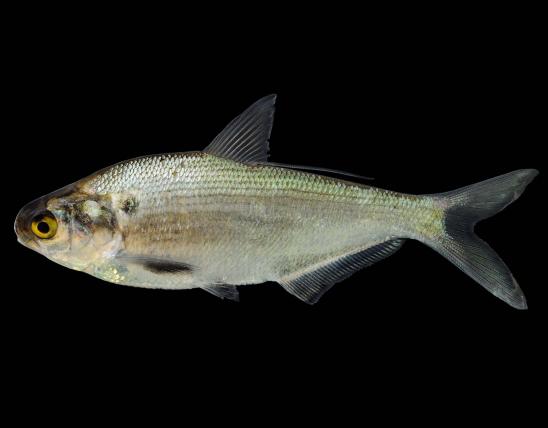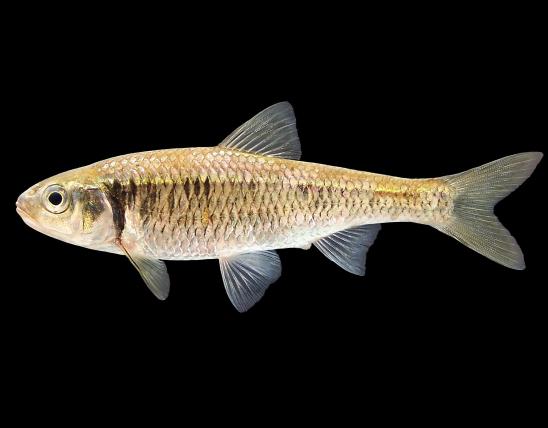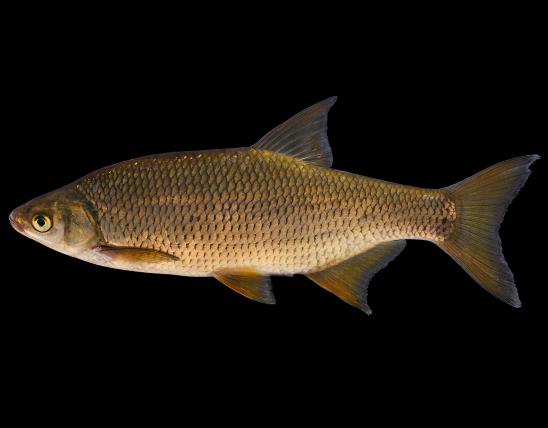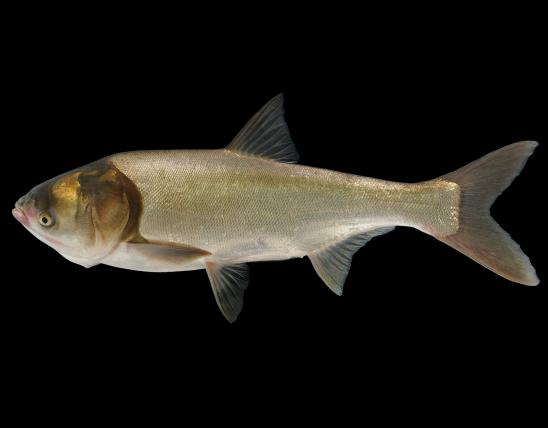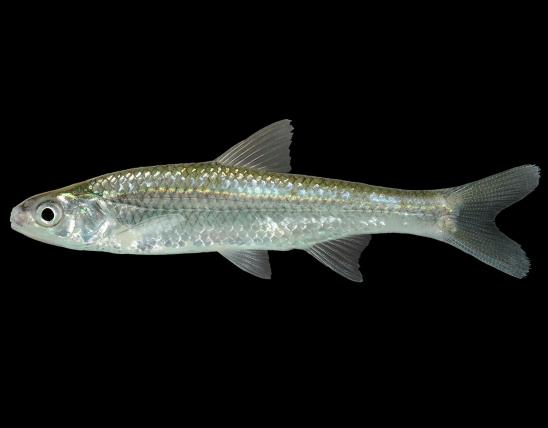
The goldeye, and the closely related mooneye, are both silvery, flat-sided fishes with large eyes and prominent teeth on the jaws, roof of the mouth, and tongue. A fleshy keel runs along the midline of the belly. The upperparts are greenish with silvery or golden reflections; the sides and belly are silvery white.
The goldeye can be separated from the mooneye by the following:
- The dorsal fin contains 9 or 10 rays, with the front of its base slightly behind the front of the anal fin base
- The fleshy keel along the midline of the belly extends from the vent forward nearly to the bases of the pectoral fins.
- The eyes are relatively smaller than in the mooneye, the diameter usually going 3.6 to 4 times into the head length.
- The iris of the eye is golden (not silvery).
- The body is more slender, its depth going about 3.4 to 3.7 times into the standard length.
Similar species: Mooneye and goldeneye both resemble herrings; both groups have a small triangular projection (called an axillary process) above the base of the pelvic fin, and both have smooth-edged (cycloid) scales over the body but not the head. However, unlike herrings, members of the mooneye family have prominent teeth, and the midline of the belly in mooneyes is keeled but lacks the row of spiny scutes found in herrings. Also, the dorsal fin in mooneyes is immediately above the base of the anal fin rather than far forward as in herrings, and a lateral line is present.
Adult length: commonly 14–16 inches; maximum length and weight for Missouri specimens is about 18 inches and 3 pounds.
Rather common in the Missouri River and the larger prairie streams of central and northwestern Missouri. In the Mississippi River, it is more common below the mouth of the Missouri River than above.
Habitat and Conservation
The goldeye is most often found in the open waters of large rivers, where it frequents areas with strong current as well as quiet pools. One may occasionally encounter it in the deeper pools of small rivers and creeks that are tributaries of large rivers. The goldeye is more tolerant of continuous high turbidity than the mooneye.
Food
The goldeye is an active, fast-moving fish that takes much of its food at or near the surface of the water. Much of its feeding is done in late evening or at night. The diet includes a wide variety of animal life, but aquatic and terrestrial (land) insects are most important. Small fishes also are commonly taken.
Status
Although the mooneye family now has its own separate order (Heidontiformes), the mooneye family used to be classified in the bony-tongue order (Osteoglossiformes), a group that includes the African knifefish, elephant-nose mormyrids, and arowanas you may have seen in tropical fish aquariums. You might notice that some references still list mooneyes in that order.
Life Cycle
Spawning activities seem to occur soon after ice breakup. In Canada, spawning occurs in late May when the ice goes out, but here, ripe females have been collected from the Missouri River in late February, when the water temperature was 32 F. Young (less than 1 inch long) have been collected from the Missouri River in late May. Spawning apparently occurs in midwater. Rare for freshwater fish, the eggs float free in the water, and the newly hatched larvae float for a time at the water’s surface with the body vertical and the head uppermost.
In males, the front rays of the anal fin are longer than in females, giving that fin a distinctive shape.
Human Connections
The soft, bony flesh of these fish generally is little valued as food, but smoked goldeye is considered a delicacy in Manitoba and Ontario. In these Canadian provinces and adjacent parts of the United States, a commercial fishery exists based on the market for smoked goldeye. Look online for tips on how to brine and hot-smoke goldeye.
The goldeye can provide some sport when taken on light tackle, although it lacks stamina. It usually makes a short, swift run or jumps a few times, then permits itself to be reeled in without further struggle. Flies or fly-and-spinner combinations are the most effective artificial lures for taking the goldeye. They also can be caught on grasshoppers, crickets, or small minnows.
A minor league baseball team in Canada is named the Winnipeg Goldeyes, and some of their recent logos depicted a gold-eyed, pointy-toothed fish holding a bat. Missouri baseball fans will find it interesting that the first Winnipeg Goldeyes team was affiliated with the St. Louis Cardinals and later with the Kansas City Royals. Try to think of other sports teams named after fish.
Ecosystem Connections
Mooneye and goldeye are visual predators that limit populations of insects and other small animals. They are preyed upon by larger fish, plus fish-eating birds, reptiles, and mammals.
There are only two living species in the mooneye family (Hiodontidae), the goldeye and the mooneye. They are restricted to North America, and both occur in Missouri. Three extinct species are also known. Mooneyes resemble shads or herrings but are not in the shad/herring family. The name comes from their large eyes, which have a metallic silvery or gold shine.
The species name, alosoides, means “shadlike.” Shad are in the shad/herring family.


























